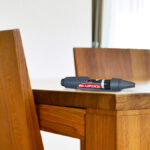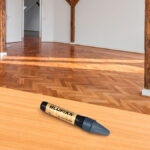Whether it was fixing a broken object or joining parts together – adhesives are often the quick fix for repairs. But what happens when the repair is done?
Unsightly adhesive residue is often left behind, which can affect not only the appearance but also the function of the repaired object. These adhesive residues are stubborn and removing them can be a tedious task that requires special solvents and tools.
But don’t worry, in this article we will present the best techniques for removing adhesive residues after repairs and introduce an innovative alternative from BLUFIXX that avoids the formation of adhesive residues.
- Problem: Adhesive residue after repairs can affect the aesthetics and function of the repaired object.
- Challenge: Removing adhesive residue can be tedious and often requires special solvents and tools.
- Innovation: BLUFIXX offers a solution that prevents the build-up of adhesive residue.
In the following sections, we will delve deeper into the topic, take a closer look at various methods for removing adhesive residue and illustrate the benefits of BLUFIXX technology.
REMOVING ADHESIVE RESIDUE: AN OVERVIEW OF COMMON METHODS
If you have ever tried to remove adhesive residue after a repair, you know how difficult it can be. The most common methods fall into three main categories: chemical solvents, mechanical methods and heat application.
Chemical solvents are often effective, but can damage the surface and pose health risks. They dissolve the adhesive residue, making it easy to wipe off. But be careful: you should always read the safety instructions on these products and wear suitable protective equipment.
Mechanical methods such as scraping or sanding the adhesive residue are another option. However, they carry the risk of damaging the surface and can be time-consuming.
Applying heat is a gentler method but can still damage the material, especially if it is heat sensitive. The heat dissolves the adhesive, making it easy to wipe off the adhesive residue.
Methods for removing adhesive residue:
- Solvents: These chemical substances dissolve the adhesive residue, but can damage surfaces and pose health risks.
- Mechanical methods: Techniques such as scraping or sanding can be effective, but carry the risk of surface damage.
- Heat: A gentler method that dissolves the adhesive, but can damage heat-sensitive materials.
DEFINITION: SOLVENT
Solvents are liquids that are able to dissolve other substances without causing chemical changes.
PROBLEMS AND RISKS: REMOVING ADHESIVE RESIDUE
Although the above methods are often successful, they also have some disadvantages.
The use of chemical solvents can pose health risks and can also damage the surface from which the adhesive is removed. In addition, they are often odor-intensive and can lead to unwanted results if used incorrectly.
The mechanical removal of adhesive residues can also cause surface damage, especially to sensitive materials. It also requires considerable physical effort and can be time consuming.
While the application of heat can be an effective method, it also requires caution. Excessive temperatures can damage the material, especially if it is sensitive to heat.
Risks and dangers at a glance:
- Health risks: chemical solvents can be harmful to health and require the use of protective equipment.
- Risk of damage: Both chemical and mechanical methods can damage the surface from which the adhesive is removed.
- Time required: Mechanical methods and heat application often require more time and effort.
EXPERT TIP:
When using solvents and applying heat, always follow the safety instructions and test the method on an inconspicuous area first to avoid possible damage.
THE CLEVER SOLUTION: BLUFIXX AS A SOLVENT-FREE ALTERNATIVE
Given the challenges associated with traditional methods of removing adhesive residue, the innovative technology of BLUFIXX makes sense.
BLUFIXX uses a light-curing technology that not only simplifies bonding and repair, but also avoids the problem of adhesive residue in the first place.
With the BLUFIXX SMART REPAIR repair pen, you can easily repair cracks and damage on almost all surfaces and materials. The product is not an adhesive, but a repair gel that you can shape and correct as you wish. The gel only hardens in 3 to 15 seconds when you expose it to the high-quality BLUFIXX LED lamp.
BLUFIXX in a quick check:
- Innovation: BLUFIXX uses light-curing technology that makes bonding and repairing easier and avoids adhesive residue.
- Ease of use: BLUFIXX SMART REPAIR repair gel is easy to apply and shape.
- Fast and efficient: The gel hardens in 3 to 15 seconds when exposed to the blue light of the BLUFIXX LED lamp.
DEFINITION: LIGHT-CURING TECHNOLOGY
Light-curing technology refers to a process in which light-sensitive materials are cured by irradiation with light.
WHY CHOOSE BLUFIXX? THE ADVANTAGES AT A GLANCE
Using BLUFIXX has many benefits that make it an excellent choice for your repair needs. Below are some of the most outstanding benefits.
First of all, the application of BLUFIXX is simple and precise. The repair gel remains liquid and can be easily corrected and aligned until it is exposed to the LED light.
Thanks to the innovative light-curing technology, BLUFIXX offers fast curing. As soon as the LED light shines on the repair gel, it hardens in a fraction of a second, without any waiting time.
BLUFIXX is also a cost-efficient solution. With BLUFIXX, expensive repairs or new purchases can be avoided, saving you time and money.
Finally, BLUFIXX is flexible and versatile. It can be used on a wide range of materials and surfaces, from glass and stone to metal and plastic.
Advantages at a glance:
- Simple application: The repair gel is easy to correct and align.
- Fast curing: The gel cures in fractions of a second when exposed to LED light.
- Cost-efficient: With BLUFIXX, expensive repairs or new purchases can be avoided.
- Versatility: BLUFIXX can be used for a wide range of materials.
EXPERT TIP:
For best results, apply the repair gel in layers and allow each layer to cure completely before applying the next.
PRACTICAL APPLICATIONS OF BLUFIXX
BLUFIXX is a versatile tool that is suitable for a wide range of repairs. From repairing a crack in a glass vase, to fixing a broken spectacle frame, to filling a chipped tile – BLUFIXX makes it possible.
It is also used in various industries, from construction to electrical engineering, to carry out repairs quickly and efficiently.
Areas of application in detail:
- Glass repair: you can easily repair cracks in glass objects with BLUFIXX.
- Spectacle repair: A broken spectacle frame can be easily fixed with BLUFIXX.
- Tile repair: Chipped tiles can be filled with BLUFIXX.
Industrial applications: In industries such as construction and electrical engineering, BLUFIXX serves as an efficient repair solution.
EXPERT TIP:
For best results, clean the surface before application and apply the gel in layers, allowing each layer to fully cure before applying the next layer.
AVOID GLUE RESIDUE WITH BLUFIXX
Removing adhesive residue can be a tedious job. That’s why you should look at repair options in advance to anticipate this problem. BLUEFIXX is the perfect tool for this.
Discover our wide range of products now and let us convince you of their effectiveness!
FAQ
HOW CAN YOU REMOVE ADHESIVE RESIDUE?
Adhesive residues can be removed with solvents, mechanical methods such as scraping or grinding, or by applying heat. Each method has its own advantages and disadvantages, which should be taken into account.
HOW CAN YOU AVOID GLUE RESIDUE?
With innovative products such as BLUFIXX SMART REPAIR, adhesive residue can be avoided. This light-curing repair gel can be shaped as desired and only hardens when exposed to blue light.
WHAT HOUSEHOLD REMEDIES CAN BE USED TO REMOVE ADHESIVE RESIDUES?
Home remedies such as cooking oil or vinegar can help to remove glue. However, these should be used carefully to avoid possible surface damage.
Get in touch with us
Do you have a question about one of our services or would you like to contact us in general? Please use the following form.
Contact us
Do you have any questions about BLUFIXX products or your order?
We will be happy to help you at the following e-mail address:
info(at)multipac.de
All fields in the contact form are mandatory.





